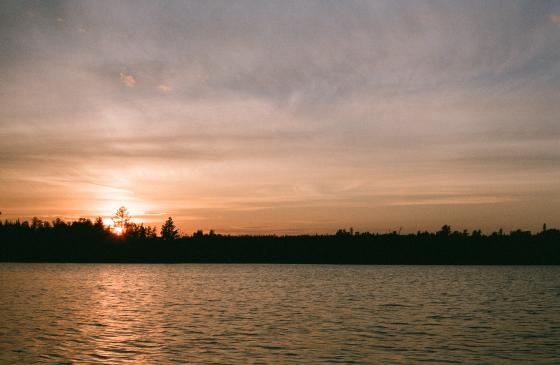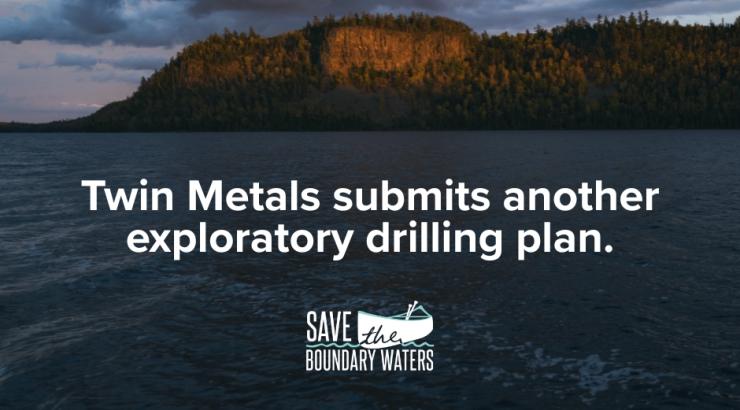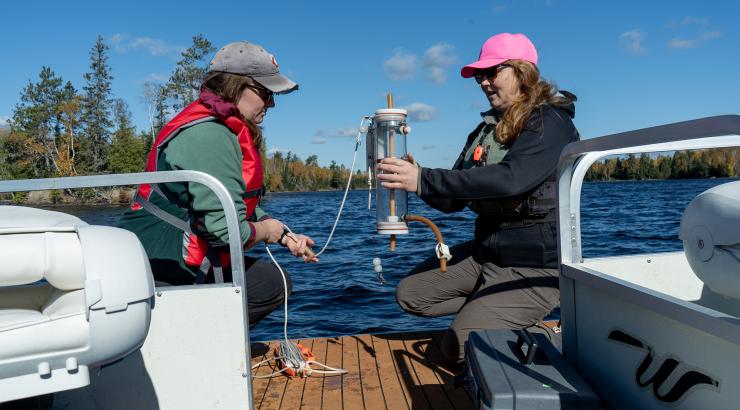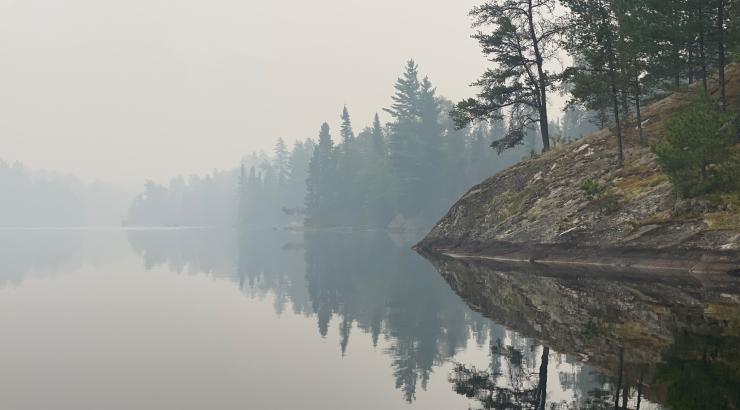The Campaign to Save the Boundary Waters leads the fight to protect the Boundary Waters Canoe Area Wilderness, Voyageurs National Park, and Quetico Provincial Park from the threat of sulfide-ore copper mining in the now-unprotected headwaters of the Rainy River Drainage Basin. Northeastern Minnesotans for Wilderness (NMW), the founder & lead organization of the Campaign, believes that all people deserve clean and safe water, and joins others in pushing for stronger, more effective laws and rules, and vigorous enforcement of new and existing laws and rules to protect and restore clean water.
THE WATER AND THE WATERSHED
Twenty percent of all the freshwater in the entire 193-million-acre National Forest System is here, in the Superior National Forest. In an increasingly thirsty world, that is a priceless resource. The waters of the Boundary Waters watershed are among the cleanest in America; the Minnesota Pollution Control Agency calls them “immaculate,”[1] but the highest compliment may come from the many experienced Boundary Waters paddlers who take water straight from the middle of the cool deep lakes … cup-to-lake-to-mouth means really clean.
A huge portion of the waters in the Boundary Waters flow into the Wilderness from Superior National Forest lands outside the Wilderness boundary. The water is not magically pure. The watershed that is continually receiving precipitation and releasing the flowing water – that is what is so special and must be protected if the water is to remain clean and healthy.
THE DANGER
A place defined by water cannot be protected unless the sources of the water flowing into and through it are also protected. Voyageurs National Park, the Superior National Forest, and the Boundary Waters Canoe Area Wilderness, Minnesota’s crown jewel and the nation’s most visited Wilderness Area, are vulnerable to the most toxic industry in America. Large international mining conglomerates are laying claim to large swaths of public land in the unprotected portions of the Rainy River Drainage Basin to mine for copper, nickel, and other metals in low grade sulfide-bearing ore. Sulfide-ore bodies generate acid mine drainage.
The solution is to eliminate permanently the threat to the Boundary Waters and the larger Quetico-Superior ecosystem[1] by banning once and for all sulfide-ore copper mining in the Rainy River Drainage Basin.
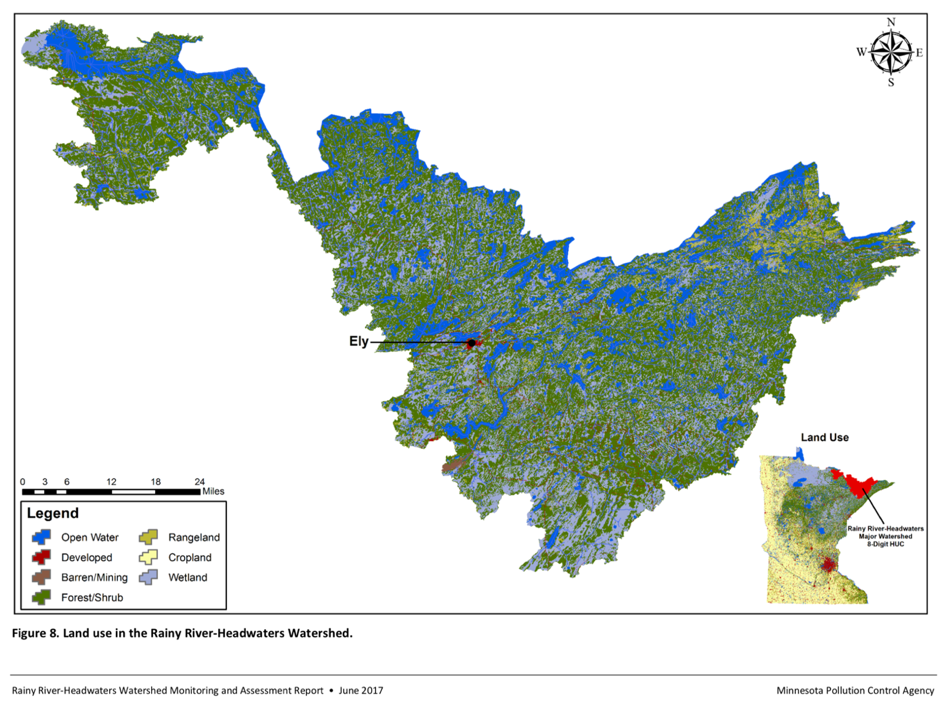
THE CAMPAIGN TO SAVE THE BOUNDARY WATERS
Since 2013 the Campaign to Save the Boundary Waters has designed and worked to advance a clear multi-step plan for a permanent ban on sulfide-ore copper mining on public lands in the Rainy River Drainage Basin. Accomplishments resulting from the Campaign’s advocacy at the federal and state levels include, for example:
-
- Cancellation by the United States of the only two federal mineral leases in the Superior National Forest, which was accomplished in 2016 by the withholding of consent by the U.S. Forest Service to renewal applications and by the subsequent lease termination by the Bureau of Land Management. When the Trump Administration reversed course, NMW and its partners sued. They filed:
- A federal lawsuit in 2018 to reverse the illegal reinstatement by the Trump Administration of the two leases.
- A second federal lawsuit in 2020 challenging the Trump Administration’s renewal of the reinstated leases
- Cancellation by the United States of the only two federal mineral leases in the Superior National Forest, which was accomplished in 2016 by the withholding of consent by the U.S. Forest Service to renewal applications and by the subsequent lease termination by the Bureau of Land Management. When the Trump Administration reversed course, NMW and its partners sued. They filed:
-
- A 2-year administrative pause on issuance of new federal mineral leases or prospecting permits in the Rainy River Drainage Basin while the U.S. Forest Service conducted environmental review of a 20-year administrative ban on new federal mineral leasing and related activities in the Rainy River Drainage Basin.
- The Campaign wrote and submitted detailed technical comment letters in support of the U.S. Forest Service proposed mining ban.
- The Campaign organized the delivery of more than 180,000 citizen comments to the U.S. Forest Service, 98% of which supported the proposed ban.
- A 2-year administrative pause on issuance of new federal mineral leases or prospecting permits in the Rainy River Drainage Basin while the U.S. Forest Service conducted environmental review of a 20-year administrative ban on new federal mineral leasing and related activities in the Rainy River Drainage Basin.
When the Trump Administration abruptly cancelled the environmental review shortly before it was to be finalized, the Campaign took further action.
-
-
- NMW spun off new organizations equipped to do independent electoral work, and to certify qualified political candidates in key races as Boundary Waters Champions.
- The Campaign is calling upon the Biden Administration to re-initiate the U.S. Forest Service request for a 20-year ban on mineral leasing in the Rainy River Drainage Basin, start a new 2-year pause to allow the Forest Service to complete the required review, and order a full 20-year administrative withdrawal of 234,328 acres of public land and minerals from the federal mineral leasing program.
- The Campaign will submit updated technical comments to the U.S. Forest Service and organize delivery of hundreds of thousands of new citizen comments in support of a 20-year ban on mineral leasing on federal lands in the Rainy River Drainage Basin.
- Supporting passage of a federal law to permanently protect federal lands in the Rainy River Drainage Basin from mineral leasing and supporting a companion state lawbarring new state mineral leases and barring state permits for any sulfide-ore copper mining in the Rainy River Headwaters.
- The Campaign has been working to raise awareness of the issue and support for legislation in Congress since 2013 and has been working similarly with the Minnesota Legislature.
- The Campaign has been working to raise awareness of the issue and support for legislation in Congress since 2013 and has been working similarly with the Minnesota Legislature.
- Challenging Minnesota’s nonferrous mining rules with a lawsuit brought under the Minnesota Environmental Rights Act.
- Relief requested in the lawsuit is an amendment to Minnesota’s nonferrous mining rules to prohibit sulfide-ore copper mining in the Rainy River Headwaters.
- The Minnesota DNR has agreed to a stipulation that establishes a process for public input and a contested case hearing. Mining company Antofagasta/Twin Metals has objected to the stipulation. A decision by the judge is expected soon.
-
In addition, Northeastern Minnesotans for Wilderness has pushed for vigorous enforcement of stronger and more effective water rules and standards. NMW has:
-
- Commented in opposition to the MPCA’s omission of certain wild rice waters from its proposed list of wild rice waters, and in opposition to MPCA’s proposed replacement of the existing 10 mg/L sulfate standard for wild rice waters with an overly complicated and unenforceable equation-based sulfate standard; (see NMW’s 2017 letter -- https://bit.ly/3bWfykz)
- Joined a Minnesota Environmental Partnership comment letter in opposition to the MPCA’s proposed Class 3 and 4 water quality standards revisions, which would leave wildlife without protections from a host of mining-associated pollutants, such as specific conductance, hardness, and chloride; (see MEP’s 2021 letter -- https://bit.ly/3eS1OZR)
- Provided oral comments in a March 9, 2021 virtual hearing by the MPCA on the following points (which will be addressed in written comments before April 9th):
- That the MPCA should not downgrade stream designations and hence protections until it first had collected and interpreted data on the streams in question, because decision-making in the absence of data invites error.
- That development of an aquatic water quality standard (WQS) for specific conductance should be a higher priority for the agency, in light of the science available on the harm to aquatic life when specific conductance is too high.
- That developing a Class 2 WQS for sulfate should be given a higher priority than it apparently is, as the MPCA has said it likely will not move to the next phase before 2023 (which is no guarantee that it would move to the next stage by any particular date). That this failure is particularly disappointing in light of the extensive body of peer-reviewed, published science on sulfate’s bioactivity on N (nitrogen), P (phosphorus), and Hg (mercury) release into the water column, and the formation and bioaccumulation of methyl-mercury in fish and the people and wildlife who depend upon and enjoy fishing.
- That it was troubling that the MPCA might be thinking of combining sulfate and chloride, because in some places that might allow excessive chloride and sulfate.
- That the MPCA should be enforcing the sulfate standard for wild rice currently on the books. That standard was approved by EPA decades ago and has the force of federal law, which the MPCA is obligated to enforce. The state legislature cannot override federal requirements except to impose more stringent ones, so the MPCA must not be dissuaded from its duty by state law purporting to block enforcement of the standard.
- Urged the Minnesota Attorney General’s office to challenge rules promulgated by the Trump Administration’s EPA relating to Section 401 of the Clean Water Act.
- In its comments on the proposed rule, the MPCA wrote that “Under the proposed rule, Minnesota would be expected to watch and wait as a regulated facility deposited heavy metals in its waterways, rather than preemptively address [the pollution]. It is likely that a second copper nickel mining facility will be proposed and begin environmental review (and potential permitting processes) in Minnesota; EPA’s proposed rule would leave us unable to address potential water quality concerns in or near the Boundary Waters Canoe Area Wilderness – waters within which are prohibited Outstanding Resource Value Waters (Minnesota Rule, or Minn. R. 7050.0335).”
- The Minnesota Attorney General joined with other Attorney Generals to challenge the proposed EPA rules.
Before European occupation, nearly the entire landmass that is the continental United States produced water as clean as the cup-to-lake-to-mouth water that paddlers still find in the Boundary Waters. While most other landscapes were heavily converted to non-natural uses, the Rainy River-Headwaters, which encompasses and delivers water to more than 80% of the Boundary Waters and is a sub-watershed of the Rainy River Drainage Basin, remains more than 99% undeveloped, naturally vegetated, and used for timber production, hunting, fishing, hiking, and other recreational opportunities. For clean water’s sake, in the Boundary Waters and downstream, let’s keep it that way.
[1] MPCA. 2017. Rainy River-Headwaters Watershed Monitoring and Assessemnt Report, p. 1
[1] The Quetico-Superior ecosystem is an international border-straddling lake-and-forest landscape, the protected core of which includes the Superior National Forest (including the Boundary Waters Canoe Area Wilderness) and Voyageurs National Park on the U.S. side, and the Quetico and LaVerendrye Provincial Parks on the Canadian side of the border. https://www.mdpi.com/1999-4907/10/9/747/htm
